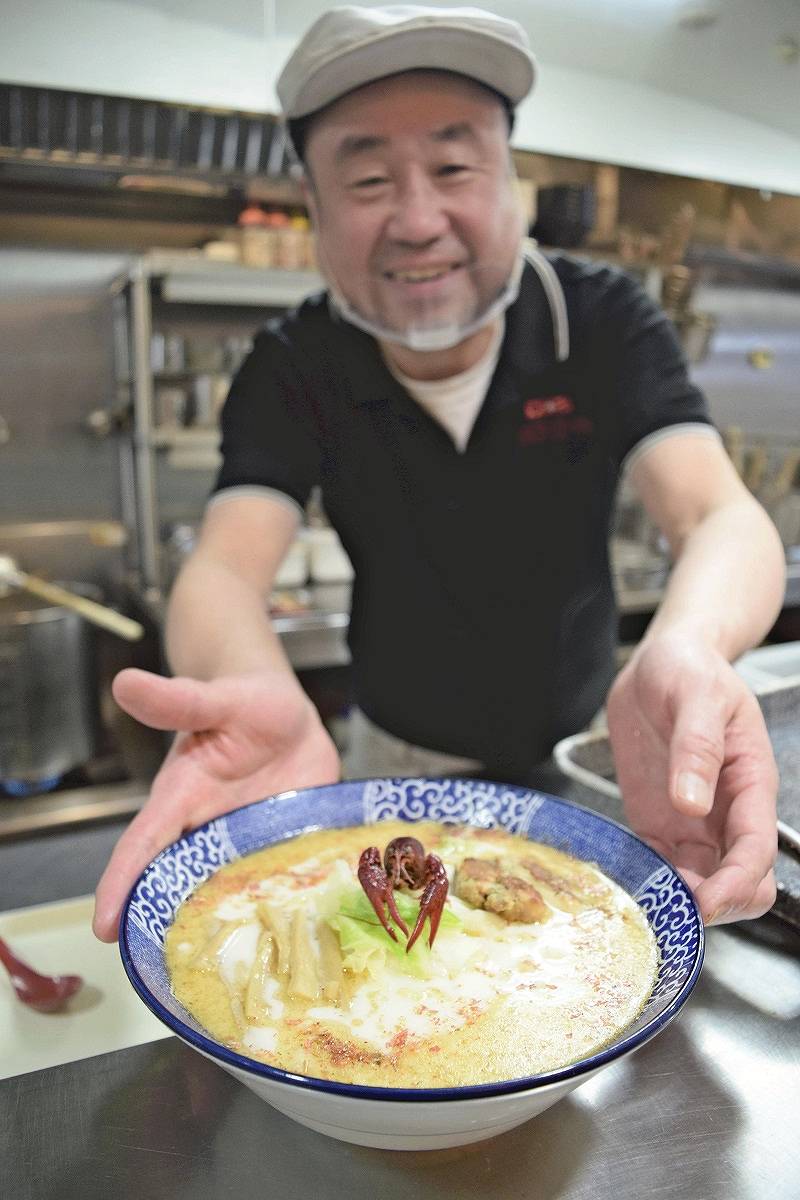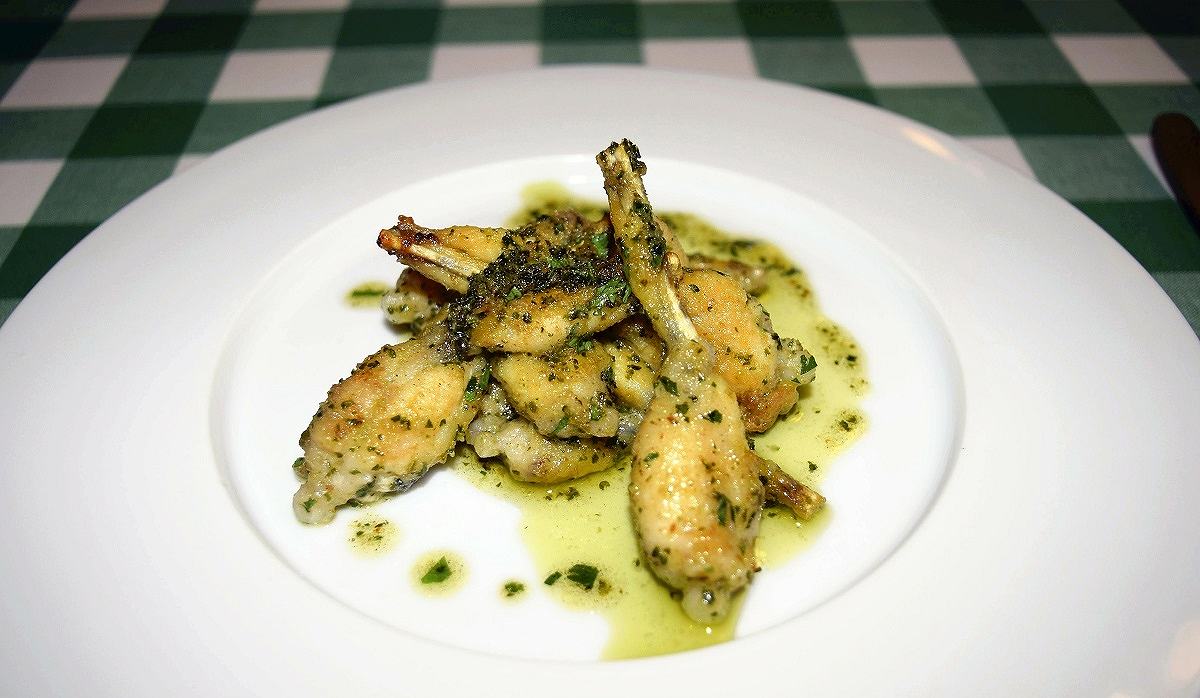
Kinya Kagayama serves Zarikko Paitan Ramen, containing red swamp crayfish and American bullfrog, at Seiten no Kaze ramen shop in Tsuruoka, Yamagata Prefecture.
12:32 JST, July 11, 2023
YAMAGATA — Helping the environment and ecosystem can sometimes be as easy as ordering a meal.
Having heard about a ramen shop and a French restaurant both serving invasive alien species, such as red swamp crayfish and American bullfrogs, in Yamagata Prefecture, I had to go and see what the food was like.
Chicken-like-taste
I first visited the Seiten no Kaze ramen shop in Tsuruoka, Yamagata Prefecture. The shop served Zarikko Paitan Ramen, which surprisingly had a mild taste despite having a tonkotsu-based broth. The ramen had red swamp crayfish powder sprinkled on, giving it a distinct flavor, as well as sauteed American bullfrog and boiled red swamp crayfish. The presentation and unfamiliar taste were jarring at first, but the slightly salty flavor captivated my taste buds, and I could not put my chopsticks down.
The toppings were delicious. It might be a cliche, but the bullfrog tasted like chicken.
The invasive amphibians were caught at the Miyakozawa wetlands by Tsuruoka City Community Nature Study Center Hotoria as part of the city’s pest control measures and provided to the restaurant. The 7.7-hectare wetland, which was formerly a rice paddy, provides a habitat for various native species, including heikebotaru fireflies and Japanese weatherfish. The shop’s owner, Kinya Kagayama, started serving the dish using nonnative species in 2020 because he “wanted to help society through ramen.”
Kagayama donates ¥100 per serving of the ramen, which costs ¥950 including tax, to the Hotoria study center.
Last year, the ramen was sold as a limited edition menu item from November to December, with only 10 portions served each day.
“I hope our ramen helps customers care about the environment and learn about the problems caused by invasive species,” Kagayama said.
‘Not unusual’ in France

Sauteed American bullfrog at French restaurant Bistro des Ponts in Mikawa, Yamagata Prefecture
Next, I visited the French restaurant Bistro des ponts in the neighboring town of Mikawa. The restaurant serves a lunch special called Hotoria Shicchi Hozen, which is made using ingredients provided by Hotoria. The special, priced at ¥1,000, comes with red swamp crayfish bisque, sauteed American bullfrog, bread, salad and a drink. The bisque, in particular, was very good. I almost thought it was made with lobster.
Seeing frogs and crayfish on the menu at a French restaurant is not unusual.
The restaurant’s chef, Keishi Sato, trained in France and learned how to prepare American bullfrogs and red swamp crayfish. However, importing those ingredients from overseas was expensive, making it difficult to incorporate them into a lunch menu.
“The meat we use comes from the Miyakozawa wetlands,” said Sato, 59. “I’m sure it has a fresh flavor because pesticides aren’t used in the wetland.”
Both Bistro des Ponts and Seiten no Kaze are not currently serving bullfrog or crayfish dishes as the ingredients are not in stock. However, they hope to start serving the dishes again later this year.
Tie up with eateries
Both American bullfrogs and red swamp crayfish are from North America, and Japan began importing them before World War II. The bullfrogs were used for food and the crayfish were used to feed the frogs. The two species can now be found nationwide.
American bullfrogs are already designated as an invasive alien species, meaning it is illegal to keep them as pets or release them into the wild. Red swamp crayfish, however, only received the designation in June, as many children kept them as pets. Rules regarding red swamp crayfish are not as strict, so such crayfish are still allowed to be kept as pets, but they cannot be sold, imported, exported or released into the wild.
Hotoria has been trapping invasive species at the Miyakozawa wetlands since the organization was formed in fiscal 2012. In 2014, Hotoria began providing nonnative species to eight local restaurants to serve to their customers, hoping it would help raise awareness about the issue.
The organization had provided a total of 160 kilograms of American bullfrogs and 500 kilograms of red swamp crayfish as of fiscal 2022. As it is said that the crayfish caught now are smaller than before, thanks to the efforts of the organization, restaurants are finding it more difficult to use them. Hotoria has thus asked a local food processing company to make crayfish powder.
“To keep trapping [invasive species] over a long period of time, it is essential to increase eatery collaborators that support the local economy, ” said Takeshi Ueyama, 41, deputy director of Hotoria.
If the group is able to succeed in its mission to eradicate invasive species, it will become impossible to serve them at restaurants.
“It will be a pity if we are no longer able to serve those delicious dishes, but that will be best,” said Sato.
Finish ‘as soon as possible’
Invasive species that have been caught are generally killed and discarded. However, there are many projects nationwide that utilize them.
Around Lake Biwa in Shiga Prefecture, fried black bass sandwiches are sold and fish meal made from bluegills are fed to cattle. In one project in Hamamatsu in Shizuoka Prefecture, compost is made using red-eared sliders.
However, when such projects aimed at making effective use of invasive species expand, it can require higher costs in terms of transporting and processing, putting pest control activities at risk of being neglected.
“Firstly, we need to completely prevent and eradicate invasive species as soon as possible,” said Tomomi Kataoka, the chairperson of the nonprofit organization Seitai Kobo, which conducts pest control activities in Tokyo. “That will help us protect native species and lead to fewer invasive species that we have to eliminate in the future.”
"Features" POPULAR ARTICLE
-

Sanrio to Open Museum in Yamanashi Pref. Dedicated to Founder, Exhibits Include Hello Kitty, Other Characters
-

Autumn Foliage Surrounds Visitors to Tokyo’s Showa Kinen Park
-

My Daughter No Longer Speaks to Me, But I Want to See Her and My Grandchild
-

Kumamoto: Public Bath Refurbished as Library Where You Can Chat, Take Photos
-

Frozen Vegetables: Demand Rises for Convenient, Tasty Domestic Produce
JN ACCESS RANKING
-

Keidanren Chairman Yoshinobu Tsutsui Visits Kashiwazaki-Kariwa Nuclear Power Plant; Inspects New Emergency Safety System
-

Imports of Rare Earths from China Facing Delays, May Be Caused by Deterioration of Japan-China Relations
-

University of Tokyo Professor Discusses Japanese Economic Security in Interview Ahead of Forum
-

Japan Pulls out of Vietnam Nuclear Project, Complicating Hanoi’s Power Plans
-

Govt Aims to Expand NISA Program Lineup, Abolish Age Restriction




















